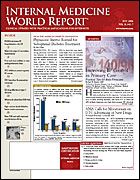Endoscopic Plication a Promising Treatment for GERD
LOS ANGELES—A new endoscopic treatment for gastroesophageal reflux disease (GERD) was found to be superior to a sham procedure in improving GERD symptoms and allowing patients to discontinue use of proton pump inhibitors (PPIs), said Richard Rothstein, MD, chief of gastroenterology and hepatology, Dartmouth-Hitchcock Medical Center, Lebanon, NH, at Digestive Disease Week 2006.
The Plicator procedure is a 20-minute outpatient technique that tightens the lower esophageal sphincter (LES).
Other endoscopic procedures for the treatment of GERD, such as EndoCinch and Stretta, have come under fire for their lack of durability and failure to enable patients to completely discontinue their use of PPIs.
The EndoCinch procedure, or endoscopic gastroplication, is an endoluminal technique in which a series of stitches is inserted just below the LES to create a pleat in the sphincter, which alters the valve to reduce reflux. In the Stretta procedure, a catheter guided through an endoscope delivers controlled radiofrequency energy to create thermal lesions in the muscle of the LES.
According to Dr Rothstein, the Plicator offers the potential for better long-term results than either EndoCinch or Stretta. “The Plicator does a transmural plication that results in more profound remodeling of the cardia,” he said. “This may translate into more durability.” However, with only 6-month outcomes reported, the potential for enhanced durability is still speculative.
In the first trial of the Plicator, 78 patients were assigned to endoscopic plication, and 81 were assigned to a sham procedure. After 3 months, patients in the sham procedure group underwent endoscopic plication.
To be eligible for the trial, patients had to have mild symptomatic GERD with a proven response to PPIs and an LES pressure >5 mm Hg. They could not have severe esophagitis or changes consistent with Barrett’s esophagus.
P
On per protocol analysis, 65% of patients randomized to endoscopic plication and 20% randomized to the sham procedure had a ≥50% improvement in GERD-related quality-of-life scores ( <.001) at 3 months, which was the primary end point of the study. In previous sham-controlled trials of endoscopic therapies, the sham response rate was 30% to 40%, noted Dr Rothstein.
P
In an intent-to-treat analysis, 56% of the treated group and 18.5% of the sham group ( <.001) achieved the primary end point.
P
Furthermore, more than twice as many treated patients stopped taking PPIs compared with sham patients (57% vs 25%; <.001). The percent reduction in median time with a pH <4 was also significantly superior in the active treatment group.
An interim 6-month analysis was available for 78 patients. “All showed sustained improvement in GERD symptoms and PPI cessation,” said Dr Rothstein. At 6 months, 53% of treated patients had discontinued PPIs.
In previous open trials of the endoscopic plication procedure, 70% of patients stopped taking PPIs at 1 year, and 63% still did not need them at 3 years.
“The quality-of-life data were also consistent between 3 and 6 months,” he said.
A second plication may augment the efficacy and durability of the procedure and should be investigated, said Dr Rothstein, adding that with one plication, pH normalized in only about one third of patients.
There were no major significant complications. Most complications were related to anesthesia or secondary to the procedure itself.
Individuals with uncomplicated GERD who are unhappy with lifelong PPI therapy and are unwilling to undergo surgery are candidates for endoscopic treatment. “Patients should think about endoscopic treatment of GERD if they understand our outcomes at the moment,” Dr Rothstein said.
Endoscopic treatment can also serve as a “bridge” that will still permit patients to undergo surgery or resume taking PPIs, he said.
